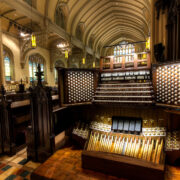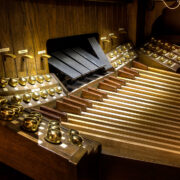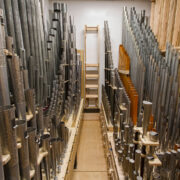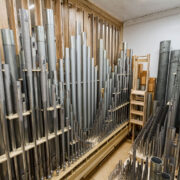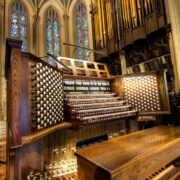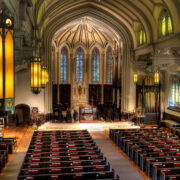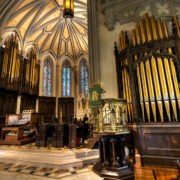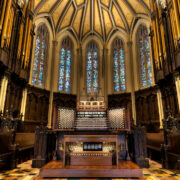Holy Trinity Lutheran Church
Holy Trinity Lutheran Church
Buffalo, New York
Opus 43 - 2016
Thanks to significant and ongoing gifts from the Margaret L. Wendt Foundation, the original 1949 M.P. Möller pipe organ at Holy Trinity has grown from its original size of 43 sets of pipes to its present 151-set grandeur. The main chancel console has five keyboards, 220 drawknobs, and 63 tilting tabs; the more modest gallery console has three keyboards, 93 drawknobs, and 15 tilting tabs. The entire instrument can be played from either console.
With so many additions and embellishments over the decades, the time had come to reconsider all the material from a fresh perspective. In 2014, the Wendt Foundation made it possible for the Church to commission a major renovation from Parsons. This project has dealt comprehensively with the Great, Positiv, Swell, Choir, and Pedal sections, and has made minor adjustments to the Grand-Choir and Solo departments. Apart from re-wiring, no work has been undertaken on the gallery sections.
In the Chancel right, the original pipes have been retained but almost everything else has been created new. All departments have been re-sited to optimize both tonal egresses — getting the tone out of the chamber — and access to pipes and mechanisms, for improved service. Gaps have been filled in the chamber walls, which have also been strengthened and repainted, and the opening into the church’s side aisle was increased. New lighting in the chamber was installed for improved visibility.
The Swell and Choir departments reside in the corner of the chamber within thick new maple swell boxes fitted with heavy shutters on two sides, controlled by new expression motors. The Great division speaks directly from the enlarged side aisle opening to fulfill its role in leading congregational song. The Positiv division continues to speak from immediately behind the chancel façade. New slider windchests built in the Parsons shop are fed from a revised winding system. Special care was taken in the design of the windchests, and the order of stops on windchests, to promote blend and solid tuning. A few sets of pipes have been exchanged (for example, the new Choir Concert Flute), all flue pipes cleaned and revoiced, and the reed pipes reconditioned.
The console rebuilding was mostly practical in nature; worn keyboards in the chancel console were replaced with new keyboards from P&S Organ Supply in England featuring bone naturals and ebony sharps. Both Chancel and Gallery consoles received updated controls for the new custom-designed solid-state control system from Integrated Organ Technologies, which features unlimited combination capability. New discrete LED lighting has been incorporated into the chancel console as well for improved visibility for the organist.
The Grand Choir and Solo sections, to the left of the chancel, have had a few modest upgrades at this time: a new 32-16 Waldhorn unit in the Skinner style replaces a collapsing Möller set; a few solo registers re-sited for improved egress; the chorus work gone through to correct speech. Both blowers for these departments have been relocated to a new blower room and feed a modestly revised winding system. The former blower room has become a part of the Grand Choir chamber to improve tuning and service access. Crowning the reconstituted instrument is the new “Bigham Tuba,” voiced by Christopher Broome on 15” wind. This stop honors Mr. Bigham’s 40 years’ dedicated service to the congregation and community.
All chancel sections were tonally site-finished from May to November 2016 by Parsons’ Tonal Director Duane Prill and Boston-based technician Jonathan Ambrosino.
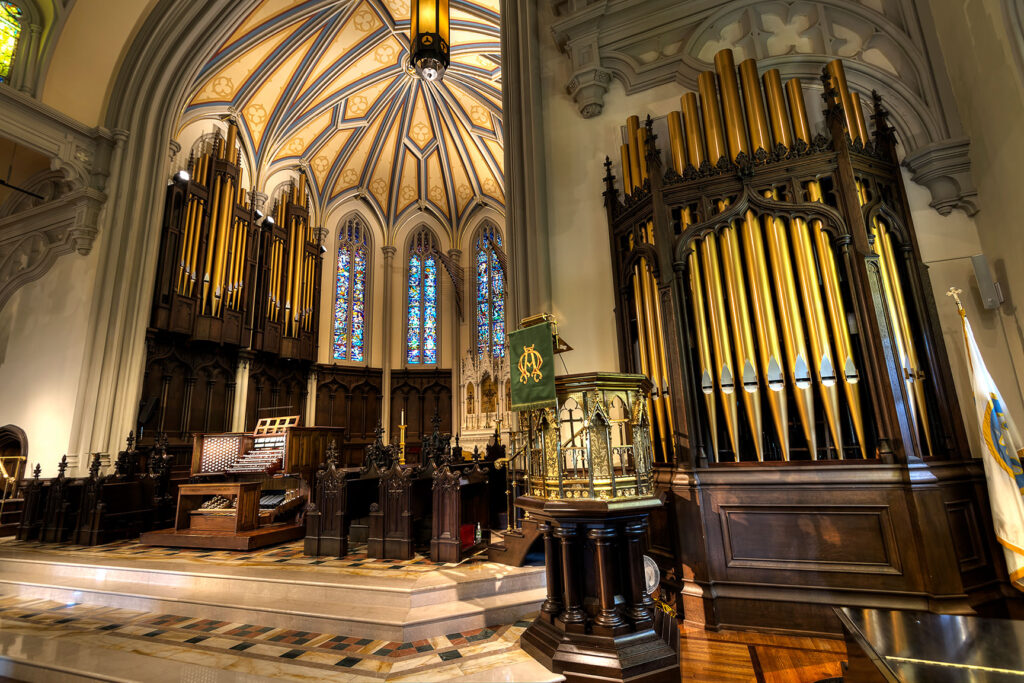
STOP LIST
Sounds
- 1 – “Hymn improvisation” Organist: Ivan Bosnar 3:33
- 2 – “Fantasie-Chorale No. 1 in D-flat Composer: Percy Whitlock; Organist: Ken Cowan 11:06
- 3 – “Improvisation” Organist: Ivan Bosnar 4:52
- 4 – Improvisation on “Lo, He Comes with Clouds Descending” Organist: Ivan Bosnar 10:10
- 5 – “Rákóczi March” Composer: Hector Berlioz; Organist: Ken Cowan 6:31

